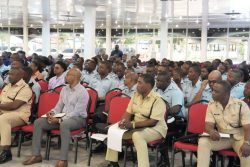With the grant to Muri Brasil Ventures Inc of the right to apply for as many as 18 prospecting licences for rare earth elements and other minerals in a pristine area that covers 2.2 million acres, chartered accountant Christopher Ram is warning that the country’s territorial integrity and national security could be compromised and he is urging President Donald Ramotar to scrap the agreement.
Minister of Natural Resources and the Environment Robert Persaud, who granted the Permission of Geological and Geophysical Survey (PGGS) to the company, should also be relieved of any ministerial duties, Ram argued yesterday in a post on the controversial award published on his blog, where he pointed to “several and dangerous implications” arising from the minister’s actions.
“President Ramotar has only one option in this matter: scrap the Permission and relieve Robert Persaud of any ministerial duties,” he wrote, after voicing concern that the grant could expose the country’s border with Brazil and also noting ties between one of the company’s principals and senior government officials.
“Guyanese will now wait to see if Ramotar will define himself and protect the integrity of the borders of this country,” he added, saying that decisive action on this issue will give some credibility to his presidency.
Persaud has faced intense scrutiny over the last week for surreptitiously granting permission for the mineral surveying in the sensitive New River Triangle area for rare earth elements, bauxite, limestone, nephelene, syenite, gold, diamonds and granite stones for a period of 36 months from November 7, 2012.
According to the PGGS, dated November 7, 2012, Muri Brasil Ventures Inc has the “right to apply” to the Guyana Geology and Mines Commission (GGMC) and shall be granted a maximum of 18 licences once it satisfies attendant requirements. It also said that the GGMC shall treat such applications on “a priority basis.”
Ram noted that the rights granted by the minister covers an area of 2.2 million acres of Guyana. “That is over 4% of the land mass of Guyana. The Permission does require the holder to give up at least 25% of the area after the first year and the Permission itself is for a three-year period. But those periods do not in any way restrict the size of any one licence which the government is compelled to issue, or the period over which the 2012 Permission can develop into prospecting, and finally into mining licences,” he observed.
He also drew attention to the fact that the revenue which the government will collect over the three year period is a “paltry US$85,000.” In the first year, he noted, the permission fee works out at 1.14 US cent per acre, and for the second and third years the fee is 1.82 US cent per acre per year. “Clearly the minister places very little value on the resources of this country,” he said.
Ram added that the company has permission to survey for at least seven distinct types of minerals and he argued that the opportunities and financial incentives to explore for these are proportionately greater than other surveyors limited to one mineral, such as gold or petroleum. “With the GGMC controlled by the minister as if it is a unit of his loosely defined ministry, any expectation that the GGMC would or could competently oversee the execution of the permission seems hopelessly misplaced,” he added.
The location of the permission area, Ram pointed out, is at the confluence of the Kuyuwini and Essequibo rivers and is right on the border.
He charged that if the minister had done the kind of background research which one associates with such major decisions, he would have recognised that the national policy was against any commercial activity in the area. “And had he applied his mind to his action he would have recognised that a potential consequence of his decision is a practical erosion of Guyana’s border since the issue of the 18 prospecting licences leading to mining in the area will render the border exposed and vulnerable,” he further argued.
Ram noted that the Guyana Defence Force (GDF) had previously voiced opposition during an earlier attempt under the Cheddi Jagan administration and he questioned whether its policy had changed.
He also argued that the GDF is given a place on the Board of the GGMC to ensure that the country is not exposed to such threats. “The tragedy is that the law allows Persaud to bypass the GGMC and engage in the kind of recklessness starkly demonstrated by the MURI Permission,” he, however, lamented. Under the Mining Act, Permissions for Geologi-cal and Geophysical Surveying are strictly within the domain of the minister.
Another area of concern for Ram is the capacity of the persons involved in the venture. He pointed out that Muri Brasil Ventures Inc was incorporated in Guyana just months before the issue of the permission, with a very modest authorised share capital of 100,000 shares with a minimum issue price of $1 each.
“You would expect that the minister would have caused to be carried out a thorough due diligence of the application and applicants, including all statutory compliance and money-laundering clearance, of all the persons behind Muri,” he said.
Two of the directors are Yucatan Reis, who is believed to be a Brazilian national and Dean Hassan, formerly of North American Resour-ces Incorporated Limited. The Secretary of the company is David Bacchus—a name that Ram said has long been associated with the GGMC and mining.
Hassan, Ram said, has friends in high places and he pointed out that both Persaud and the Prime Minister were prominent by their presence at a Christmas party he hosted on Friday night at the New Thriving Restaurant.
While the Ministry of Natural Resources has said that there has been no attempt to mislead on the PGGS, questions remain and main opposition APNU plans on grilling Persaud over the award of the grant at this week’s sitting of the National Assembly.
To this end, APNU MP Joseph Harmon has submitted questions on leases and permits issued in the New River Triangle Area or contiguous areas; all leases, licences, and permits issued for mining operations in regions 7, 8 and 9; and forestry concessions issued over the period November 1, 2012 to November 1, 2013 in regions 7, 8 and 9.








